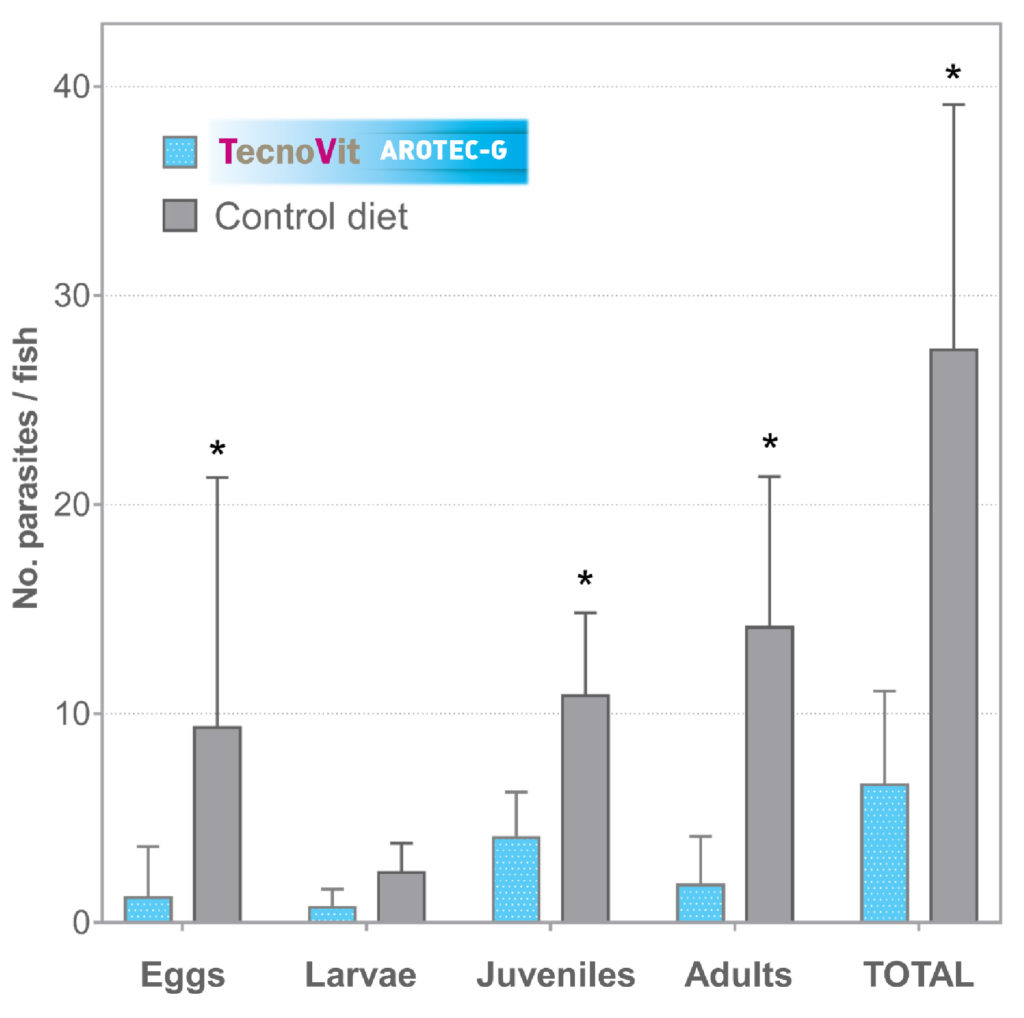More than a MICROCAPSULE

AROTEC-G® offers an effective and sustainable strategy for the control of the ectoparasite Sparicotyle chrysophrii in gilthead seabream farming
AROTEC-G® is a microencapsulated functional product composed of a blend of garlic essential oil, carvacrol and thymol with numerous productive, welfare and environmental advantages. These widely recognised compounds are well-known for their antiparasitic, antimicrobial, anti-inflammatory and antioxidant properties, without any detrimental effect for the final consumer, or the environment. Besides, the exclusive microencapsulation technology ensures the stability of the compounds and a sustained release throughout the gastrointestinal tract. The efficiency of AROTEC-G® against bacterial and parasitic challenges has been scientifically proven through both in vitro and in vivo experimental studies.
A trial with juvenile gilthead seabream fed with an AROTEC-G® supplemented diet for two months was performed in order to discover its effects upon the pathogen´s main portals of entry, i.e., mucosal tissues, such as gills, skin, and intestine.
Gills were particularly studied to evaluate the protective effect of AROTEC-G® against the ectoparasite Sparicotyle chrysophrii, one of the main pathogenic agents affecting gilthead seabream farming in the Mediterranean. In this regard, AROTEC-G® inclusion in the diet promoted the modulation of genes involved in immunity routes, redox processes, and metabolism in the gills. In particular, processes mediated by cells of the innate immune system, such as granulocytes, were preponderant. This potential immunoprotective effect of AROTEC-G® in gills was corroborated by an in vivo cohabitation challenge, in which fish fed with the product were subsequently exposed to S. chrysophrii for another month of feeding. The administration of AROTEC-G® decreased by 78% the total prevalence of the ectoparasite in gills, particularly affecting adult, juvenile and egg stages of the parasite (Figure 1).

Figure 1. Number of S. chrysophrii parasites per fish fed with the AROTEC-G® and control experimental diets (mean ± standard deviation). Asterisks (*) indicate significant differences between dietary groups (p < 0.05). Adapted from Firmino et al. 2020 (https://doi.org/10.1038/s41598-020-74625-5).
The effect of AROTEC-G® upon the skin was also studied. Results obtained from the analysis of the epidermal mucus revealed a significant decrease in stress biomarkers, mainly cortisol, when animals were fed with AROTEC-G®, indicating an improvement in overall fish health condition and welfare. Moreover, the mucus from fish fed with AROTEC-G® also significantly inhibited the in vitro growth of pathogenic bacteria, particularly fish pathogens such as Vibrio anguillarum and Pseudomonas anguilliseptica (Figure 2). Those results were supported by the modulation of genes related with immunity and secretory responses in skin.
Similarly, according to the intestine analysis, the activation of granulocytes was also suggested to be the main actor of the mucosal immune response promoted by AROTEC-G®. The compound did not affect fish growth performance or gut microbiota diversity, although subtle variations in microbiota composition and functionality were suggested to participate in the modulation of the intestine immune and antioxidative profile observed in fish fed with AROTEC-G®. Gilthead seabreams fed with the AROTEC-G® supplemented diet did not show any intestine histopathological alterations, proving that AROTEC-G® administration is safe to be included in functional diets to improve fish mucosal health.
Since the traditional use of chemotherapeutic agents to prevent and control fish diseases in aquaculture has been heavily criticised, the overall results of AROTEC-G® supplementation demonstrated promising potential for this product to be used as a sustainable prophylactic tool in the health management for aquaculture farms.

Figure 2. V. anguillarum, P. anguilliseptica, and Escherichia coli growth inhibition on skin mucus of gilthead seabream fed with a diet supplemented with AROTEC-G® and a control diet. Asterisks (*) indicate significant differences in bacterial growth between dietary groups (p < 0.05). Adapted from Firmino et al. 2021 (https://doi.org/10.3389/fimmu.2021.633621).


